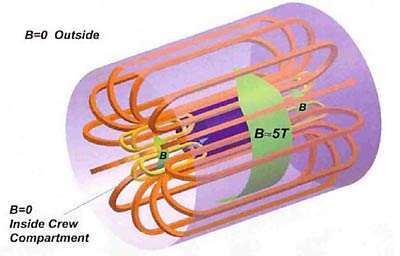
Posted on 01/24/2005 6:22:41 PM PST by KevinDavis
It’s the year 2027 and NASA’s Vision for Space Exploration is progressing right on schedule. The first interplanetary spacecraft with humans aboard is on course for Mars. However, halfway into the trip, a gigantic solar flare erupts, spewing lethal radiation directly at the spacecraft. But, not to worry. Because of research done by former astronaut Jeffrey Hoffman and a group of MIT colleagues back in the year 2004, this vehicle has a state-of-the-art superconducting magnetic shielding system that protects the human occupants from any deadly solar emissions.
New research has recently begun to examine the use of superconducting magnet technology to protect astronauts from radiation during long-duration spaceflights, such as the interplanetary flights to Mars that are proposed in NASA’s current Vision for Space Exploration.
(Excerpt) Read more at thespacereview.com ...

Bump to read later
You can tell this is science fiction. When was the last time something of NASA's progressed right on schedule?
Shields up!
| If I had the stuff, I'd use it for things like this. Hot babes beat spacecraft. |
Link that baby to a naquada (sp?) reactor, and viola, instant wormhole.
Hey - be nice. It doesn't take NASA a whole lot of scheduling ability to sit on it's collective thumb for that length of time.
ping
Actually, Robert Zubrin talked about this in his description of the MAGSAIL. See "Islands in the Sky" Pub 1996. If I'm not mistaken, he's been working on this since 1988 for sure. I don't recall if the idea originated from him or from Dana Andrews.
I've also used the magsail back in 2002 when I described the positioning and placement of a solar power satellite in an NSO, 10 million km from the sun in a feasibility study I created. The only difference is I used a brute force approach for creating a magnetic field, eliminating superconductors since power isn't a problem. Besides, the magnetic field needed to deflect charged particles in earth orbit only amounts to 52 nano-teslas and 11,600 nano-teslas 10 million km from the sun. By way of comparison, a regular refrigerator magnet's field is 4,000 times greater that wha would be required. Insisting on superconductors given the abundance of solar energy seems silly to me.
Bump for cool stuff.
Now if they can discover an elegant way to produce gravity.
thanks for the input. However, the earth's magnetic field isn't based upon superconductivity and is more than sufficient in shileding the earth.
Consequently, to my way of thinking, any magnetic field of sufficient strength to prevent charged particles from punching through is a good thing.
You know, try reading "Islands in the Sky" (Schmidt and Zubrin. Eds). Zubrin makes a compelling case for the Magsail.

It seems that every argument against humans in space is slowly being chipped away. Step by step..
Disclaimer: Opinions posted on Free Republic are those of the individual posters and do not necessarily represent the opinion of Free Republic or its management. All materials posted herein are protected by copyright law and the exemption for fair use of copyrighted works.